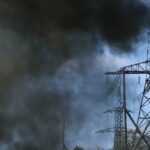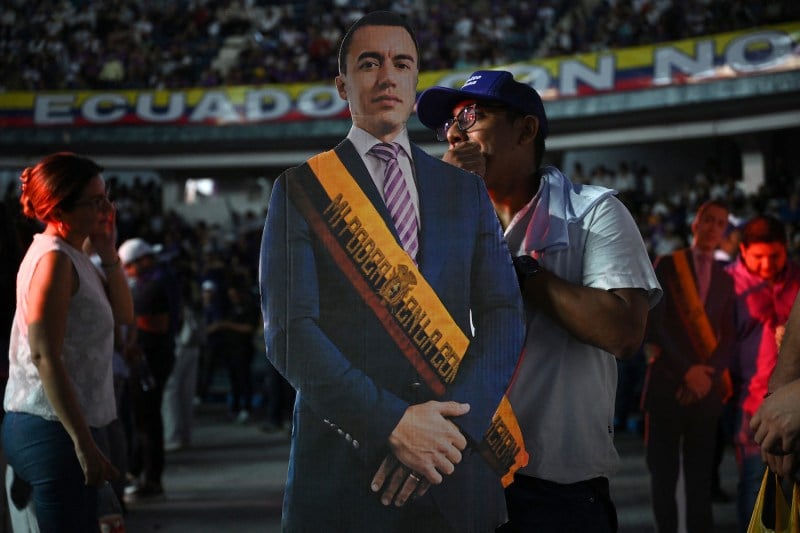On Ukraine, Split the Difference Between Trump and Biden

On Ukraine, Split the Difference Between Trump and Biden
One U.S. president deferred too much to Zelensky, while the other is trying to dictate terms.
A Patriot air defence system is installed at the military hub for Ukraine at the Rzeszow-Jasionka airport in Jasionka, southeast Poland, on March 6. Sergei Gapon / AFP
U.S. President Donald Trump has been deservedly condemned around the world for his dismissive treatment of Ukrainian President Volodymyr Zelensky and his inexplicable deference to Russian leader Vladimir Putin. But it’s easy to forget that many critics were questioning policies that were virtually the opposite and embraced by Trump’s predecessor, President Joe Biden.
As the Russia-Ukraine war settled into a long stalemate following the start of Russia’s full-scale invasion on Feb. 24, 2022, national security experts wondered why Biden seemed to shut the door to negotiation with Putin—despite saying repeatedly that talks were the only way out of the war. The former president also appeared to effectively delegate U.S. strategic policy with Russia to Zelensky, who rebuffed any compromise, even determining that direct talks with Putin were “impossible” in a decree he signed in 2022.
U.S. President Donald Trump has been deservedly condemned around the world for his dismissive treatment of Ukrainian President Volodymyr Zelensky and his inexplicable deference to Russian leader Vladimir Putin. But it’s easy to forget that many critics were questioning policies that were virtually the opposite and embraced by Trump’s predecessor, President Joe Biden.
As the Russia-Ukraine war settled into a long stalemate following the start of Russia’s full-scale invasion on Feb. 24, 2022, national security experts wondered why Biden seemed to shut the door to negotiation with Putin—despite saying repeatedly that talks were the only way out of the war. The former president also appeared to effectively delegate U.S. strategic policy with Russia to Zelensky, who rebuffed any compromise, even determining that direct talks with Putin were “impossible” in a decree he signed in 2022.
Now, Trump seems only interested in talking to Putin and appears to have no interest in hearing what Zelensky has to say, repeatedly speaking over him at a meeting during the Ukrainian leader’s visit to the White House on Feb. 28. (And a report from Politico this week indicated that Trump may even be working to quietly oust him.)
This neck-wrenching divergence of approaches is more evidence that longtime verities of U.S. foreign policy—including the idea that domestic politics stops at the waters’ edge—are relics of the past. Trump’s departure from Biden’s policies is yet another indication that in this new, virulent era of “America First,” Washington may no longer be a credible leader of the free world. U.S. allies from Europe to the Indo-Pacific will need to develop their own strategies and build up their own defenses.
Moreover, Trump has given no indication that he genuinely wants an equitable peace—as opposed to a Yalta-like solution where he cedes a substantial part of Ukraine and Eastern Europe to Putin’s Soviet-style sphere of influence. Given Trump’s clear animosity for Europe and NATO—which is illustrated by his renewed trade war—there is little sign, a month and a half into his presidency, that his views even add up to a rational set of policies.
For the first time since World War II, European Union leaders are considering a Europe-only approach, meeting with Zelensky in Brussels on Thursday to discuss an $865 billion joint defense plan.
“A new era is upon us. … Some of our fundamental assumptions are being undermined to their very core,” European Commission President Ursula von der Leyen wrote in a letter to the 27 EU members ahead of the summit.
At the meeting, outgoing German Chancellor Olaf Scholz reiterated a rejection of any U.S.-led “dictated peace” in Ukraine, and even Hungarian Prime Minister Viktor Orban, a longtime Trump ally, called for strengthening European defenses.
But the grim reality is that without Washington’s participation, it’s unlikely that there will be any kind of long-term solution to the Ukraine crisis. That may only be possible by negotiating a larger strategic understanding between the United States and Russia that goes beyond a Ukraine settlement.
The stark difference between the Biden and Trump approaches also suggests that there may be a realpolitik solution for Ukraine that lies somewhere in between—in a negotiation that accommodates the fundamental needs of both Zelensky and Putin. Such a solution would acknowledge Russia’s great-power status, to a degree, while at the same time securing Ukraine’s sovereignty and democracy—and, just as important, preserve the U.S. role in Europe.
The Trump team needs to “be creating an atmosphere around the negotiation over Ukraine that gives the Kremlin some confidence that you’re going to remain engaged with Russia even if you get this resolved,” said Thomas Graham of the Council on Foreign Relations, who is also a former Russia director on President George W. Bush’s National Security Council.
Graham added: “In a strange way, Russia’s own sense of itself as a great power is dependent on recognition from the United States. That is a point of leverage for the United States if you know how to play it.”
Trump and his team have repeatedly indicated that this scenario is what they are pushing for: a renormalization of Russia that restores a recognition of the country’s great-power status. That recognition has been missing since a decade ago, when then-U.S. President Barack Obama mistakenly downplayed Putin’s annexation of the Ukrainian peninsula of Crimea and dismissed Moscow as a “regional power” that didn’t pose a threat to the United States.
As distasteful as Trump’s appeasement of Russia may be, some observers believe that it is fair compensation for Biden’s unwillingness to engage at all. Through two and a half years, even as Biden hesitated to give Zelensky the long-range weapons and planes that he demanded, Washington continued to pretend that the goal was to force Russia’s military completely out of the country—as well as to push for the “weakening” of Russia, in then-Defense Secretary Lloyd Austin’s terms.
That prompted Russian Foreign Minister Sergey Lavrov to declare that Washington and the West had entered a “proxy” war with Russia, risking another world war that, Lavrov warned, could go nuclear.
The Biden approach was also a recipe for continued conflict, especially as the politically imperiled 46th president headed into a reelection year and feared looking politically soft. It was hardly a surprise that on the 2024 campaign trail, and most recently in his White House meeting with Zelensky on Feb. 28, Trump warned repeatedly of triggering “World War III.”
“It’s very important to explain the pitfalls of Biden’s approach,” said Stephen Wertheim, a political scientist at the Carnegie Endowment for International Peace and the author of the influential 2020 book, Tomorrow, the World: The Birth of U.S. Global Supremacy. “The Biden approach was ‘we don’t want to see Ukraine with absolute victory because that would be an unacceptable escalation,’” Wertheim added. “But we also don’t want Russia to get a total victory. So we want something in the middle. And we got something in the middle. And yet we didn’t want to negotiate. That was the Biden approach.”
In the days since Trump and Vice President J.D. Vance insulted Zelensky in the Oval Office and then kicked him out—outraging U.S. allies and delighting the Kremlin—European leaders suggested that their own solution could include a possible European peacekeeping force.
But the Kremlin has indicated that this plan may not be acceptable.
On Thursday, Lavrov dismissed European ideas on sending peacekeepers from NATO member states, saying that Moscow would consider such a deployment a NATO presence. “We see no room for compromise,” Lavrov told reporters at a news conference in Moscow.
Any European or even U.S. security guarantee to Ukraine that involved actual troops on the ground “would be a formula for escalation, not peace,” said George Beebe, a former chief of Russia analysis for the CIA and now the head of grand strategy at the Quincy Institute. He added, “But there should be a web of security assurances—things that incentivize Russian compliance with a settlement and disincentivize a future invasion.”
With any such deal, Trump would also be acknowledging the Kremlin’s central grievance—that NATO expansion drove it to aggression and must stop at its present borders. That’s not exactly a Yalta—divvying up Europe as Washington and Moscow did in 1945—but it would be an acknowledgement that Russia gets its sphere of influence in what Graham calls the “Slavic core” of the old Russian empire, including Belarus, parts of Ukraine, and perhaps parts of Kazakhstan. That is expected to be far more limited than the Kremlin’s Cold War-era control involving occupation troops.
Trump has repeatedly argued that Putin has a point in resenting NATO expansion, saying that it is what caused the war. But on Friday, for the first time since he assumed the presidency, Trump also expressed frustration with the Russian president, writing on his Truth Social platform: “I am strongly considering large scale Banking Sanctions, Sanctions, and Tariffs on Russia until a Cease Fire and FINAL SETTLEMENT AGREEMENT ON PEACE IS REACHED.” (Trump didn’t mention that Russia is already sanctioned, and his administration had previously indicated it was seeking to lift those sanctions).
It’s also important to note that whatever outrageous concessions Trump grants to Russia now, NATO is stronger and far more encompassing than it was when Putin began his war, especially with Finland and Sweden as members. Finland’s 830-mile border with Russia alone has roughly doubled NATO’s borders with Russia while Swedish forces have exercised some control over the Baltic Sea.
For Ukraine, the only way forward is still to secure some kind of U.S backing. In recent days, Zelensky has indicated that he’s ready to sign a currently vague deal that is believed to pledge a 50 percent U.S. share in future development of the Ukrainian state’s resources in minerals, oil, and gas, saying in a social media post on Tuesday it is “time to make things right” with Trump and adding that their previous encounter was “regrettable.”
“Ukraine is ready to come to the negotiating table as soon as possible to bring lasting peace closer,” Zelensky said. “My team and I stand ready to work under President Trump’s strong leadership to get a peace that lasts.”
For Trump, that response may give him what he most craves. “The main value is to provide Trump with the narrative that he thinks he needs to proceed with a supportive posture with Ukraine. So he can say ‘I have extracted a better deal than Joe Biden ever got,’” said Wertheim. A new investment deal between Ukraine and the United States could even disincentivize future Russian invasions.
Putin, handed several unilateral concessions by Trump, has not indicated that he’s ready for peace—but the Kremlin has shown a great interest in renewing a strategic relationship with Washington. And that may be enough inducement for the moment.
On Wednesday, when asked how the Kremlin viewed Zelensky’s outreach, spokesman Dmitry Peskov replied: “Positively.” But, he added, “The question is who to sit down with. For now, the Ukrainian president is still legally prohibited from negotiating with the Russian side. So, overall, the approach is positive, but the nuances have not changed yet.”
This post is part of FP’s ongoing coverage of the Trump administration. Follow along here.
Michael Hirsh is a columnist for Foreign Policy. He is the author of two books: Capital Offense: How Washington’s Wise Men Turned America’s Future Over to Wall Street and At War With Ourselves: Why America Is Squandering Its Chance to Build a Better World. X: @michaelphirsh
More from Foreign Policy
-

Samuel Huntington holds his hand to his chin while sitting in an office. Samuel Huntington Is Getting His Revenge
The idea of a global “clash of civilizations” wasn’t wrong—it was just premature.
-

U.S. President Donald Trump meets with Ukrainian President Volodymyr Zelensky at the White House on Feb. 28. The Perils of a Reality TV Presidency
The Trump-Zelensky shouting match is a reminder that international diplomacy was never meant to be carried out in front of billions of eyes.
-

A Ukrainian serviceman trains in the woods near the frontline in Ukraine. Three Years On, What’s Next for Europe and Ukraine?
Nine thinkers on the bombshells coming out of Washington.
-

Donald Trump is seen inside a helicopter at night looking down at a cell phone Trump’s New Map
America’s first post-literate president has only geography to fall back on.









Join the Conversation
Commenting on this and other recent articles is just one benefit of a Foreign Policy subscription.
Already a subscriber?
.
Subscribe
Subscribe
View Comments
Join the Conversation
Join the conversation on this and other recent Foreign Policy articles when you subscribe now.
Subscribe
Subscribe
Not your account?
View Comments
Join the Conversation
Please follow our comment guidelines, stay on topic, and be civil, courteous, and respectful of others’ beliefs.
Change your username |
Log out
Change your username:
CANCEL
Confirm your username to get started.
The default username below has been generated using the first name and last initial on your FP subscriber account. Usernames may be updated at any time and must not contain inappropriate or offensive language.